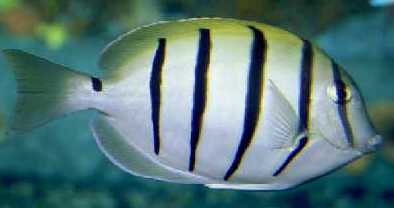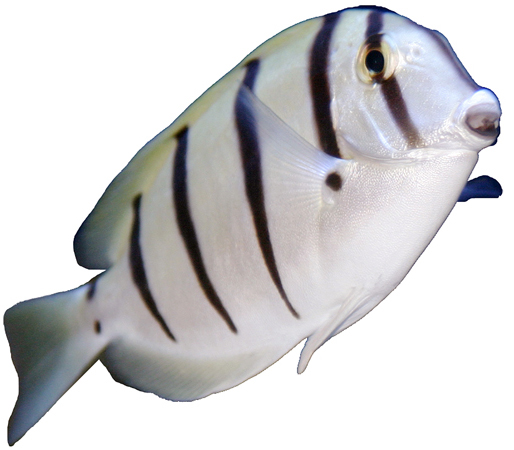Convict Surgeonfish
Acanthurus triostegus
This species is possibly the most numerous in the surgeonfish family, Acanthuridae. It is widely distributed in tropical Pacific and Indo-Pacific waters. The convict part of the common name of these fish results from the resemblance of the black bands on their creamy-white bodies to the striped uniforms once worn by prison convicts. Another common name is convict tang.

Credit: Aquarium of the Pacific

Credit: Aquarium of the Pacific
SPECIES IN DETAIL
Convict Surgeonfish
Acanthurus triostegus
CONSERVATION STATUS: Safe for Now
CLIMATE CHANGE: Not Applicable
At the Aquarium
Gulf of California
Geographic Distribution
Common in most tropical waters from east Africa through the Indo-Pacific and equatorial islands to the eastern Pacific, south from the Gulf of California through Mexico, Nicaragua, Costa Rica, Equador and in the Cocos, Clipperton, Malpelo and Galapagos Islands.
Habitat
Convict surgeonfish prefer inshore lagoon and coral reef areas with firm bottom surfaces where preferred food supplies are plentiful. Specimens have been observed from surface waters to as deep as 90 m (295 ft). Juveniles are common in tide pools.
Physical Characteristics
The body of a convict surgeonfish is oval in profile and laterally compressed. The caudal peduncle is short and supports a forward pointing, razor sharp, erectile spine in a groove on each side. The caudal fin is very slightly concave. Scales are tiny and tightly spaced. The teeth are serrated on the sides.
Body color ranges from very light olive green to almost white. The undersides are white. There are six vertical black stripes on the sides; one on the head, passing through the yellow eye, four on the body, and one on the caudal peduncle.
Size
These fish are reported to reach 27 cm (10.6 in), but most are smaller
Diet
Their preferred diet consists primarily of filamentous and other types of algae. Although primarily herbivorous, they will also feed on some benthic invertebrates. They will raid algal gardens tended by other herbivorous fishes.
Reproduction
During spawning these fish form aggregations of fairly large numbers. Spawning is at dusk when small groups of fish break away from the large groups. Females broadcast eggs into open water where the males fertilize them. Egg development is rapid and the larval offspring join the plankton population where they stay about two months. At about 2.5 cm (1in) in length they settle out of the plankton population and find protection in tide pools and other sheltered areas. As they gain size and strength they expand their roaming in the reefs until they are large enough to join schooling groups.
Behavior
These fish may be observed as solitary individuals or in aggregations or schools of hundreds or even thousands. It is not unusual to see them in the company of other algae eating fishes such as other surgeonfishes, rabbit fishes, and parrotfishes. When frightened or annoyed, they may erect their sharp caudal spines that become formidable weapons when the fish swim rapidly about.
Adaptation
Herbivores, their teeth are serrated along the edges creating small saw-like structures that assist in removing algae from the substrate.
Conservation
This species, as is the case with most smaller fishes, is subject to predation from the time the eggs are first broadcast to the time of natural death. Eggs, larvae, juveniles, and adults are all subject to being preyed upon by larger fish, such as groupers, some eels, snappers, and various other marine animals.
Where present, convict surgeonfish (tang) are considered acceptable food fish by humans and are targeted as part of the general catch of reef fish by subsistence and light commercial fisheries. Many subsistence fishers sell part of their catch to offset the cost of their fishing operation. There are reports that in some capture areas this fish may be ciguatoxic.
Relatively easy to maintain, this species is popular with home aquarists and is often seen in marine aquariums in professional offices and restaurants. Specimens are readily available from tropical fish retail stores and online services.
Prolific spawners, the species seems to be holding its own at this point in time. The IUCN Red List has not evaluated the species.
Special Notes
Eagle rays may be seen gorging on the eggs newly broadcast by convict surgeonfish during the spawning process.
SPECIES IN DETAIL | Print full entry
Convict Surgeonfish
Acanthurus triostegus
CONSERVATION STATUS: Safe for Now
CLIMATE CHANGE: Not Applicable
Gulf of California
Common in most tropical waters from east Africa through the Indo-Pacific and equatorial islands to the eastern Pacific, south from the Gulf of California through Mexico, Nicaragua, Costa Rica, Equador and in the Cocos, Clipperton, Malpelo and Galapagos Islands.
Convict surgeonfish prefer inshore lagoon and coral reef areas with firm bottom surfaces where preferred food supplies are plentiful. Specimens have been observed from surface waters to as deep as 90 m (295 ft). Juveniles are common in tide pools.
The body of a convict surgeonfish is oval in profile and laterally compressed. The caudal peduncle is short and supports a forward pointing, razor sharp, erectile spine in a groove on each side. The caudal fin is very slightly concave. Scales are tiny and tightly spaced. The teeth are serrated on the sides.
Body color ranges from very light olive green to almost white. The undersides are white. There are six vertical black stripes on the sides; one on the head, passing through the yellow eye, four on the body, and one on the caudal peduncle.
These fish are reported to reach 27 cm (10.6 in), but most are smaller
Their preferred diet consists primarily of filamentous and other types of algae. Although primarily herbivorous, they will also feed on some benthic invertebrates. They will raid algal gardens tended by other herbivorous fishes.
During spawning these fish form aggregations of fairly large numbers. Spawning is at dusk when small groups of fish break away from the large groups. Females broadcast eggs into open water where the males fertilize them. Egg development is rapid and the larval offspring join the plankton population where they stay about two months. At about 2.5 cm (1in) in length they settle out of the plankton population and find protection in tide pools and other sheltered areas. As they gain size and strength they expand their roaming in the reefs until they are large enough to join schooling groups.
These fish may be observed as solitary individuals or in aggregations or schools of hundreds or even thousands. It is not unusual to see them in the company of other algae eating fishes such as other surgeonfishes, rabbit fishes, and parrotfishes. When frightened or annoyed, they may erect their sharp caudal spines that become formidable weapons when the fish swim rapidly about.
Herbivores, their teeth are serrated along the edges creating small saw-like structures that assist in removing algae from the substrate.
This species, as is the case with most smaller fishes, is subject to predation from the time the eggs are first broadcast to the time of natural death. Eggs, larvae, juveniles, and adults are all subject to being preyed upon by larger fish, such as groupers, some eels, snappers, and various other marine animals.
Where present, convict surgeonfish (tang) are considered acceptable food fish by humans and are targeted as part of the general catch of reef fish by subsistence and light commercial fisheries. Many subsistence fishers sell part of their catch to offset the cost of their fishing operation. There are reports that in some capture areas this fish may be ciguatoxic.
Relatively easy to maintain, this species is popular with home aquarists and is often seen in marine aquariums in professional offices and restaurants. Specimens are readily available from tropical fish retail stores and online services.
Prolific spawners, the species seems to be holding its own at this point in time. The IUCN Red List has not evaluated the species.
Eagle rays may be seen gorging on the eggs newly broadcast by convict surgeonfish during the spawning process.

